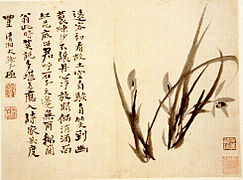Shi Tao
Shi Tao ( Chinese 石濤 , Pinyin Shí Tāo , W.-G. Shih-t'ao , maiden name Zhū Rùojí 朱 若 极, monk name Dàojì 道 濟 - Tao Chi; * 1641 Qingjiang ( Guangxi Province ); † approx. 1707) was a Chinese painter of the Qing Dynasty .
Life
Zhū Rùojí belonged to the Ming imperial family . He experienced its fall by the Manchurian Qing dynasty in 1644 as a three-year-old boy. It was only by chance that he escaped the fate intended for the members of the old dynasty. As a camouflage he adopted the name Yuanji Shitao and entered a Buddhist monastery in 1651 , where he was finally given the monk name Dàojì.
After a few years in Wuchang , in the province of Anhui as well as Nanjing and Yangzhou , Shitao moved to Beijing in 1690 . After he had found no sponsor for his rise in the monastic hierarchy there, contrary to his hopes, he converted to Daoism in 1693 and returned to Yangzhou, where he died in 1707.
plant
Shitao is one of the most famous representatives of the so-called individualistic painting school supported by learned writers during the early Qing dynasty . Initially strongly influenced by Ni Zan and Li Yong , he soon broke with traditional styles and painting techniques and created a new kind of aesthetic that makes his work almost revolutionary today.
His works are characterized by a wet painting technique and strong, impressive brushstrokes, further by the use of “subjective” perspectives and the conscious use of negative or white surfaces to create the impression of distance. Shitao's style is difficult to classify; In particular, he himself has explicitly refused to admit to the two great painting schools of the past Ming dynasty: “If you ask me whether I paint in the style of the Southern or Northern School, I hold my stomach with laughter and answer, I do do not know if I belong to a school or the school to me. I paint in my own style. "
Shitao, too, was mainly active as a landscape painter and for this purpose roamed various areas of China on numerous hikes. He often provided his sheets, usually compiled in albums, with specific location information, or even with additional comments or poems. Unlike the old master of the genre, Guo Xi , Shitao also wanted to capture the “hidden forces of heaven and earth” and make visible the unchangeable principles that determine the creation of nature and his images. " A brushstroke is the origin of all existence, the root of innumerable phenomena" admits Shitao and thus takes up recognizable Daoist ideas.
10,000 ugly ink stains is a perfect example of Shitao's subversive and ironic aesthetic principles. The work, unique in its perceptual structure, poses considerable challenges to the traditional beauty standards. The division of the carefully painted landscape into pollockesque splashes forces the viewer to realize that the picture is by no means “transparent” to the extent that it initially claims to be. It is precisely because the title describes them as "ugly" that the ink stains acquire a unique, abstract beauty.
Memories of Qin-Huai is the title of another unique work by Shitao. Like many paintings from the late Ming and early Qing dynasties, it deals with the place of man in nature. At first glance, the craggy crag in the painting looks a little disfigured, as it almost seems to “bow” to the viewer.
A monk stands quietly in the boat floating on the Qin Huai River and looks up admiringly at the stone giant. The mutual respect that humans and nature show each other is thematized here in a refined style that is reminiscent of (magical) surrealism and borders on the absurd . Shitao himself had visited the river and its surroundings in the 1680s; However, it is unclear whether he actually depicted existing locations in the album from which the sheet was taken.
Other well-known works are The Peach Blossom Spring , which is intended as an illustration to Tao Yuanming 's story of the same name, Man in a House under a Rock, and The Waterfall on Mount Lu and Colors of the Wilderness (bird watching) .
Shitao finally laid down the principles of his conception of art in the theoretical work Hua Pu [W.-G .: Hua-P'u]. He also designed gardens in Yangzhou .
ShiTao: Recorded words of the monk bitter melon on painting Mainz, 2009
literature
- James Cahill : The Chinese Painting (= The Art Treasures of Asia. Vol. 1, ZDB -ID 503322-6 ). Skira, Geneva 1960.
- Earle J. Coleman: Philosophy of Painting by Shih T'ao. A Translation and Exposition of his Hua-P'u , Mouton Publishing, The Hague, 1978. ISBN 90-279-7756-9
- Shitao: Recorded words of the monk bitter melon for painting , Dietrich'sche Verlagsbuchhandlung, Main, 2009. ISBN 978-3-87162-068-3
- Victoria Contag (Introduction): Chinese Landscapes. Twelve ink pictures by Shi-T'ao . Woldemar Klein, 1955.
| personal data | |
|---|---|
| SURNAME | Shi Tao |
| ALTERNATIVE NAMES | Tao Chi, Zhu Ruoji |
| BRIEF DESCRIPTION | Chinese painter |
| DATE OF BIRTH | 1641 |
| PLACE OF BIRTH | Qingjiang |
| DATE OF DEATH | around 1707 |




